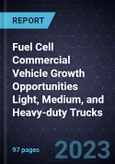Fuel Cell Trucks as an Additional Powertrain Strategy for Specific Segments and Green Hydrogen Adoption
Electrification in trucking is gaining momentum as a Mega Trend, with new mobility models shaping the industry’s future. Various sub-trends within electric vehicles (EVs), such as battery EVs (BEVs) and FCEVs, are increasingly popular as emission norms become stricter and the focus on achieving cleaner forms of goods transportation is higher. The prominence of battery electric trucks is suitable for selected applications, but range limitation and battery weight compromising the load-carrying capacity are seen as hindering features. Truck manufacturers and policymakers increasingly consider hydrogen-powered fuel cell electric trucks a viable equivalent to battery electric trucks as hydrogen offers a longer range and minimum refueling time, similar to diesel trucks.
Grey hydrogen produced from fossil fuels is a major type of hydrogen available in the market. The hydrogen industry is transitioning to blue hydrogen, where carbon is captured, reducing emissions from hydrogen production. Governments and private enterprises globally invest in green hydrogen production as they find adopters in the transportation sector and steel production. The current cost of green hydrogen production is very high, making ownership of fuel cell trucks unviable. However, policies and incentives announced in various markets support the long-term adoption of fuel cell trucks. Overall, the trucking industry is at a crossroads in determining the choice of zero emission powertrain for required applications with no one-size-fits-all solution.
Truck manufacturers and startups form partnerships with technical research organizations and government entities to explore innovative solutions for enhancing fuel cell performance. Fossil fuel companies and renewable energy companies explore efficient distribution networks for hydrogen supply across regions and aim for the use of tanker shipments or pipeline infrastructure to make hydrogen readily accessible at affordable prices at refueling stations. Governments promote localized hydrogen production to mitigate energy losses associated with hydrogen transportation. Several truck makers’ fuel cell electric trucks are in the trial phase and have launched in limited numbers, with more models in the development phase. They are set to commence trials and large-scale commercialization within this decade. Robust supply chains will be vital for manufacturers to achieve the required production volumes when market demand for fuel cell trucks surges. When companies target decreasing their fleets’ emissions, they will need to promote zero emission trucks as a practical option for their customers. Fuel cell trucks appear to be a promising choice for goods transportation; therefore, businesses must speed up their technological decisions and product development efforts to validate the performance of these vehicles.
Table of Contents
Companies Mentioned (Partial List)
A selection of companies mentioned in this report includes, but is not limited to:
- Daimler
- First Hydrogen
- Hyundai
- Paccar
- Renault
- Stellantis
- Toyota
- Traton
- Volvo








